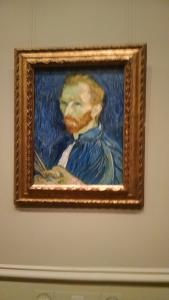Nocturne with a Line from Porchia
Everything is nothing, but afterwards.
I rise and the moon disturbs the darkness,
revealing symbols, a few stolen words
on the bureau. Tomorrow I’ll express
my gratitude by disappearing be-
fore I’m found, which is to say goodbye
before hello, a paradigm for the
prepossessed. Compton tells us to imply
what’s missing, like Van Gogh or Bill Monroe,
but why listen to the dead before they’ve
stopped speaking? Unfortunately we throw
out the bad with the good, only to save
the worst. I return to bed, and the floor
spins. Nothing is everything, but before.
* * *
This first appeared in The Blue Hour Magazine in December 2014, and is also included in my chapbook, If Your Matter Could Reform. The line “Everything is nothing, but afterwards” comes from Antonio Porchia’s Voices, translated by W.S. Merwin. Porchia wrote one book in his lifetime, but what a book it was! Often described as a collection of aphorisms, Voices is so much more – each time I open the book, I find new meaning in old lines.



It is funny that you bring up Porchia, the man that stated,”following straight lines shortens distances, and also life” when you wrote a rather deep poem about Brahma & the straight line. Could the Great Truth (i.e. greatest truth) lie between your work and his? I think a Okaji-Porchia cento is in order, a Por-kaji!
LikeLiked by 2 people
Hmm. A Porchia cento would be interesting…
LikeLiked by 1 person
Dizzying, disorienting, wonderful.
LikeLiked by 2 people
Thanks, Cate. The world is dizzying to me!
LikeLike
I recognize that spinning floor!
And I second the motion for a Por-kaji – Okaji-Porchia cento
LikeLiked by 1 person
It’s been a while since I’ve experienced the spinning floor. 🤢 The thought of a cento assembled from Porchia’s work is intriguing.
LikeLiked by 2 people
A cento assembled from Porchia’s and YOUR own work is what we are eagerly awaiting.
“The rain has died and everything follows…some things become such a part of us that we forget them.”
LikeLiked by 1 person
That would be more challenging! But fun.
LikeLiked by 1 person
PLEASE please try it. Pick the relevant lines and bless the world with a rendering of the first Por-kaji…
LikeLiked by 1 person
Porkaji sounds like something one would serve with a spicy dipping sauce. Or maybe wasabi.
LikeLiked by 1 person
Por-k would be the mix of ideas from Okaji and Porchia, and aji is (1) a spicy sauce and (2) a Japanese word for flavor. Oka is Japanese for a hill or knoll, adding ji making it a mound of earth or waiting on the hill, or the hill-side road.
My feeling? Por-kaji… the road to the hill of ultimate poetic flavor, where Por and Kaji combine to create something greater, something beyond the summit, for which one can wait no longer…
LikeLiked by 1 person
Hmm. I hope to find some of that poetic flavor over the next few months. And maybe a sauce, too.
LikeLiked by 1 person
Metempsychosis throws a rather large spanner in the works of solipsism. It’s a shame so few people ever read the next few lines of the cogito argument. The world does not fail to exist if one closes one’s eyes. Descartes would turn in his grave. So would any number of Atomists. Ever read Parmenides?
LikeLiked by 1 person
Thank you for commenting! Metempsychosis and solipsism never entered my mind while writing this, but I’m pleased you found them in your reading. No, I’ve not read Parmenides.
LikeLiked by 1 person
“After is before” is in a way prefigured in pre-existence (metempsychosis) insofar as there is a you before what you consider you to currently be. Parmenides introduces the idea that all things have already happened and it is our temporal position which gives the illusion through time of a before and after. It is the egoism of the solipsist which makes the twin mistake of thinking they are what they are and have always been what they are. You may like the work of the sculptor Eduardo Paolozzi who made a series of works entitled “as is when” which certainly owes much to this line of speculation. He was also a surrealist in his early years so there is a nice tie in here with Andre Breton; the main champion of Porchia.
LikeLiked by 1 person
Thank you for leading me to Paolozzi.
LikeLiked by 1 person
No worries. He’s an interesting fella. Happy to help!
LikeLiked by 1 person
Me again, Bob. I just re-read this in “If Your Matter Could Reform.” It’s so lovely. Now I’m belatedly going to find Porchia’s book. Thanks again — or before.
LikeLiked by 1 person
Oh, Cate! You have made my day. Thank you!
LikeLike